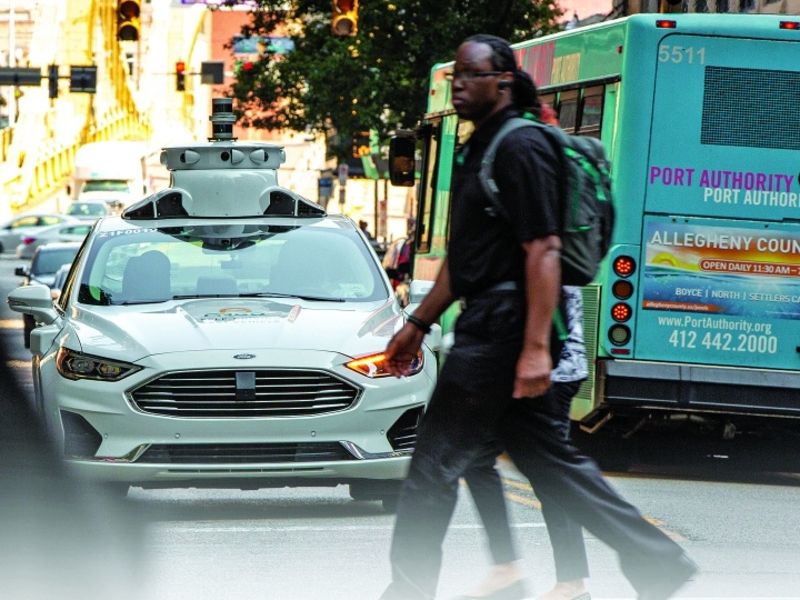
Self-driving vehicles hold the potential to deliver a safer and more efficient era of transportation, but merely replacing human drivers with automated ones only takes progress so far.
Although autonomous vehicles are engineered to function largely without reliance on the outside world, there may be benefits unlocked — both for AV companies and society at large — by connecting the two. What if they acted not as lone rangers on the road, but as voluntary contributors to a larger traffic information network?
That’s a question Argo AI sought to answer with a fellow Pittsburgh tech company, Rapid Flow Technologies, in a pilot project completed late last year. Findings were published this month, and they hint at what the future could hold.
On its own, Rapid Flow Technologies has deployed software on traffic lights to passively analyze vehicle, bicycle and pedestrian traffic at intersections and adapt signals. That can reduce delays by as much as 20 percent and decrease travel times by 16 percent.
For city transportation officials who lack the funding and often the inclination to build new roads, the numbers hint at how cities can wring more efficiency from existing infrastructure without overly expensive additions.
That’s today, with humans behind the wheel.
When self-driving vehicles reach the road in substantial numbers, the gains could be greater. Fifteen Argo vehicles in the Pittsburgh area provided Rapid Flow software with information on their whereabouts and intended routes during the project. Collectively, they reduced the time spent sitting at red lights by 40 percent, the companies said.
“That’s a pretty powerful thing,” said Pete Rander, president and co-founder of Argo AI, the self-driving tech company that works with Ford Motor Co. and Volkswagen.
“While self-driving is at the core of what we do, we’re operating in dense urban environments. Everyone is worried about congestion. Anything we can do that helps in this front, we’ll do. And from a business angle, if we are able to provide that, that potentially becomes a competitive advantage.”
Like self-driving vehicles’ on-board tech, decisions made by Rapid Flow’s software occur at the edge, meaning the data is processed on the lights themselves rather than at a centralized location. Information can be collected and passed along to the next intersection. In cities with grid-like roads, that distributed approach can hold key advantages.
“There’s no computational bottleneck,” said Griffin Schultz, CEO at Rapid Flow Technologies. “In a centralized network, you can only handle X number of intersections. With edge compute, you don’t have this problem. It grows elegantly. And you don’t have the latency of bringing all the data back to a server. You have a less-brittle network.”
The company has installed its technology in roughly 50 intersections in Pittsburgh, and has equipped intersections in Quincy, Mass., Atlanta and the metro Toronto and Philadelphia regions.
There’s a two-pronged approach to Rapid Flow Technologies’ attempts to thwart traffic congestion. One is its base software, called Surtrac, which offers the real-time adaptive signal controls based on multimodal traffic flow. Routecast, what was tested with Argo, is a more forward-looking layer on the technology that incorporates routes from users willing to provide them. Understanding routes in advance gives the software’s predictive elements better certainty in how traffic will flow.
“It improves everybody’s experience, and that leads to a step change,” Schultz said. “It’s a new way of thinking about a connected vehicle.”
Actually, it’s perhaps an old way of thinking about connected vehicles. For more than two decades, the federal government has attempted to generate traction for the so-called V2X technology that allows vehicles to transmit safety information between vehicles and infrastructure.
Launching those vehicle-to-vehicle transmissions has been delayed by years of squabbling over which method should be used to send those communications. But with infrastructure as a focal point, information could be transmitted without new equipment in cars.
Schultz says information for Routecast could be drawn from interested fleets, navigation systems embedded in cars, transit vehicles and from any road user’s cellphone. Road users uninterested in sharing detailed route information still get some traffic-reduction benefits.
In the Argo pilot project, the information flow was one-way only. Information flowed from the vehicle to the traffic light.
In the future, the lights could provide more of a two-way exchange, in which self-driving vehicles receive information on the status of traffic lights that may be occluded or receive information on how many seconds remain until a green light, so they can adjust their speeds accordingly.
“That’s a future-tense thing, we’re not claiming that is yet there,” Rander said. “What we’re really excited about with Rapid Flow is the benefits from maintaining the traffic flow and the continuity provided with traffic management. There’s much, much promise there.”
Not only for self-driving vehicles, but for every road user who might benefit from the ripple effects of broader cooperation.

